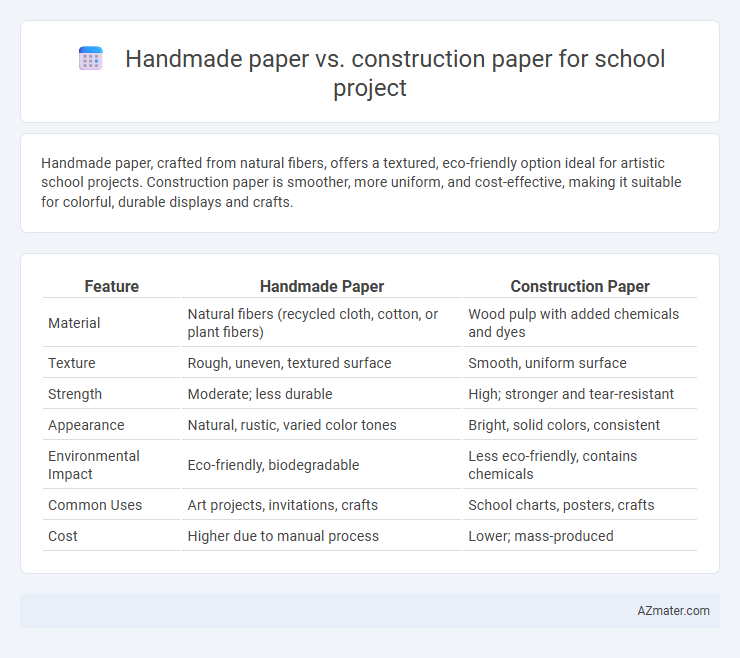Handmade paper, crafted from natural fibers, offers a textured, eco-friendly option ideal for artistic school projects. Construction paper is smoother, more uniform, and cost-effective, making it suitable for colorful, durable displays and crafts.
Table of Comparison
| Feature | Handmade Paper | Construction Paper |
|---|---|---|
| Material | Natural fibers (recycled cloth, cotton, or plant fibers) | Wood pulp with added chemicals and dyes |
| Texture | Rough, uneven, textured surface | Smooth, uniform surface |
| Strength | Moderate; less durable | High; stronger and tear-resistant |
| Appearance | Natural, rustic, varied color tones | Bright, solid colors, consistent |
| Environmental Impact | Eco-friendly, biodegradable | Less eco-friendly, contains chemicals |
| Common Uses | Art projects, invitations, crafts | School charts, posters, crafts |
| Cost | Higher due to manual process | Lower; mass-produced |
Introduction to Handmade Paper and Construction Paper
Handmade paper is crafted from natural fibers such as cotton, hemp, or recycled materials, offering a textured, eco-friendly surface ideal for artistic and environmental school projects. Construction paper is a mass-produced, sturdy paper made from wood pulp, widely available in bright colors and commonly used for cutting, folding, and simple crafting activities. Choosing between handmade and construction paper depends on the project's need for sustainability, texture, and durability.
Key Differences in Materials and Production
Handmade paper is crafted from natural fibers such as cotton, hemp, or recycled materials, resulting in a textured and eco-friendly product, while construction paper is made from wood pulp with added dyes and chemicals, offering uniform texture and vibrant colors. The production of handmade paper involves a labor-intensive, artisanal process that includes pulping, sheet formation, and drying by hand, contrasting with construction paper's mass-produced manufacturing using machines and continuous rollers. These differences in materials and production techniques influence the durability, appearance, and environmental impact of papers used in school projects.
Eco-Friendliness and Sustainability
Handmade paper is highly eco-friendly, made from recycled fibers and natural materials, minimizing chemical use and waste, which supports sustainability in school projects. Construction paper, often produced with synthetic dyes and bleaches, can contribute to environmental pollution despite being convenient for crafting. Choosing handmade paper promotes reduced carbon footprint and encourages sustainable resource use in educational activities.
Texture and Aesthetic Appeal
Handmade paper offers a unique, tactile texture with irregular fibers and natural variations, enhancing the sensory experience of school projects. Construction paper provides a smoother, more uniform surface ideal for precise cutting and layering but lacks the organic feel of handmade paper. The aesthetic appeal of handmade paper lies in its rustic, artisanal charm, while construction paper delivers vibrant, consistent colors suitable for bold and colorful designs.
Durability and Strength
Handmade paper typically offers greater durability due to its thicker fibers and natural texture, which resist tearing and wear better than construction paper. Construction paper, often made from thinner, lower-quality wood pulp, is more prone to ripping and fading when exposed to moisture or heavy handling. For school projects requiring long-lasting strength and resilience, handmade paper provides superior performance.
Cost Comparison for School Projects
Handmade paper typically costs more than construction paper due to labor-intensive production and limited availability, making it less budget-friendly for large school projects. Construction paper is mass-produced and widely accessible, offering a cost-effective option for bulk use in classrooms. Choosing construction paper helps schools manage expenses while still providing versatile materials for creative assignments.
Versatility in Crafting Techniques
Handmade paper offers unique texture and strength ideal for detailed painting, calligraphy, and mixed media art, enhancing tactile and visual appeal in school projects. Construction paper provides a smooth surface and vibrant colors that excel in cutting, folding, and layering techniques commonly used in crafting. Both materials support diverse artistic methods, but handmade paper's durability allows for more intricate work, while construction paper is favored for quick, colorful designs.
Availability and Accessibility
Handmade paper is less widely available and often found in specialty craft stores or online, making it less accessible for school projects. Construction paper is commonly stocked in most schools, art supply stores, and general retailers, ensuring easy access and affordability. The consistent availability of construction paper supports its frequent use in educational settings.
Suitability for Different Types of School Projects
Handmade paper offers a textured, eco-friendly surface ideal for artistic projects such as scrapbooking, card making, and eco-conscious presentations. Construction paper provides a sturdier, brightly colored medium suited for cutting, folding, and crafting models or posters requiring durability and vibrant hues. Choosing between them depends on project needs: handmade paper enhances creative expression with its unique fibers, while construction paper supports hands-on activities with easier manipulation and bold color options.
Final Recommendation: Choosing the Best Paper
Handmade paper offers unique texture and eco-friendly qualities, ideal for artistic school projects requiring a personalized touch. Construction paper provides vibrant colors and durability, making it suitable for crafts with frequent handling and cutting. For the best choice, select handmade paper for visual appeal and sustainability, or construction paper for affordability and ease of use.

Infographic: Handmade paper vs Construction paper for School project
 azmater.com
azmater.com